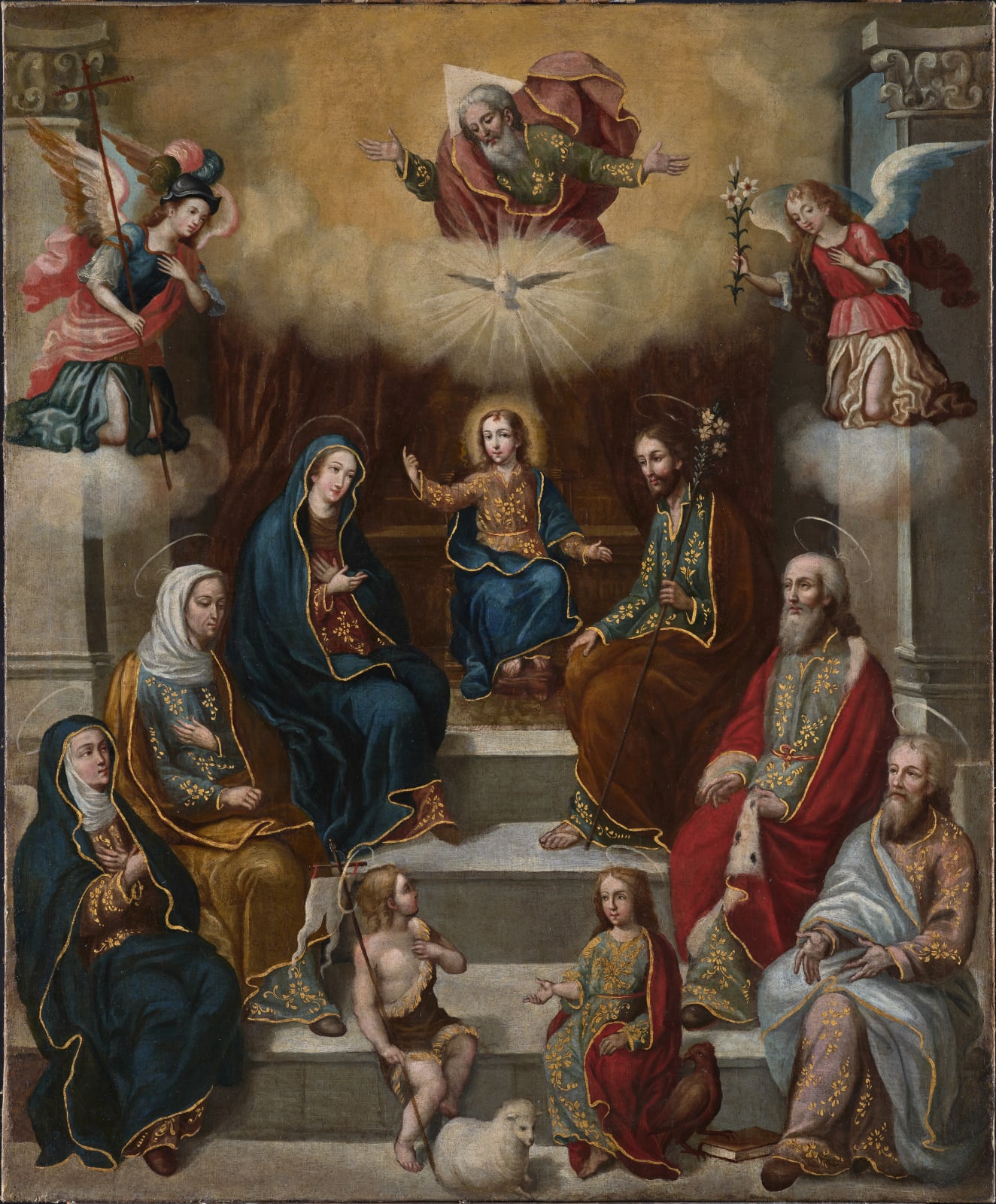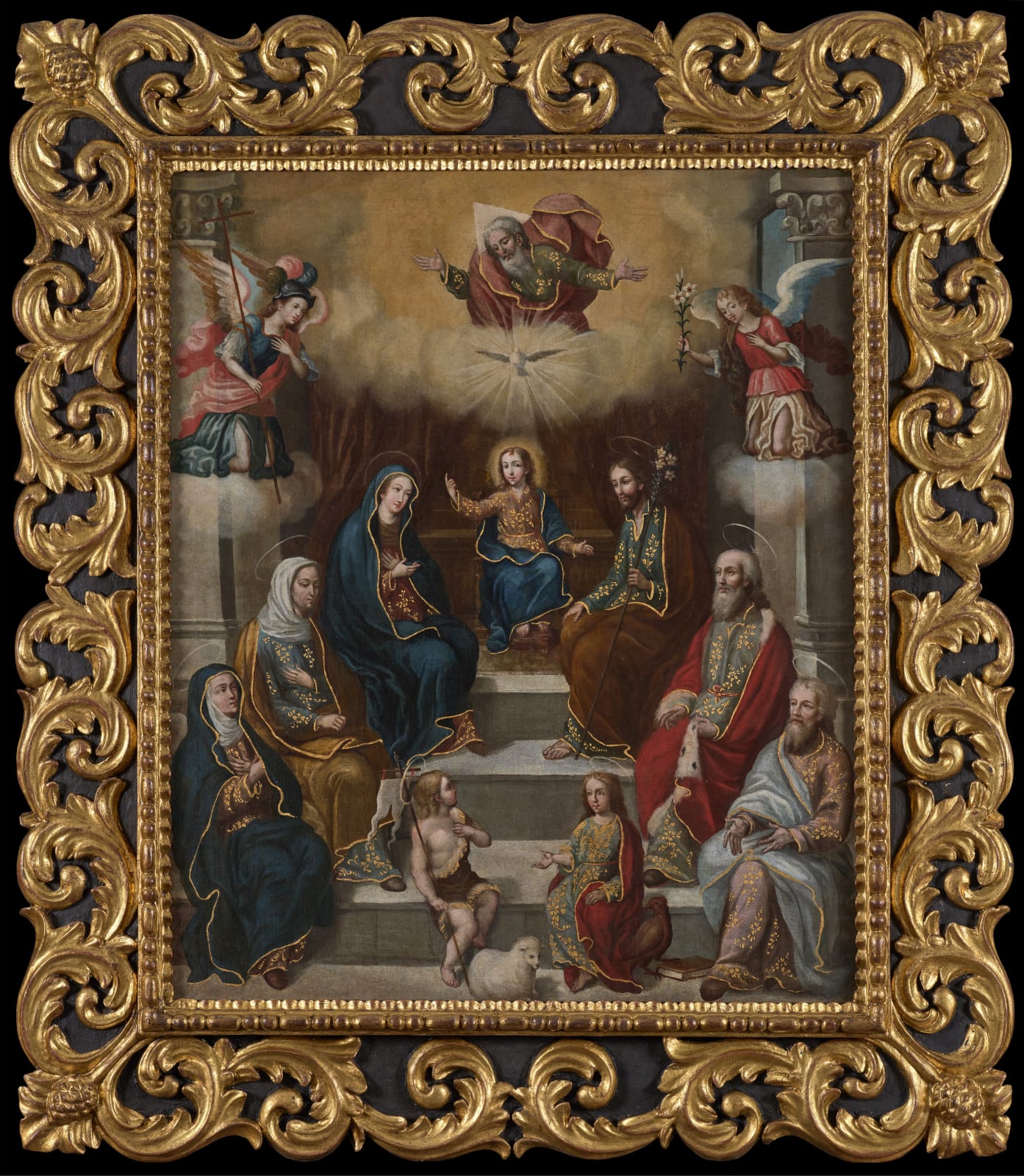HOLY KINSHIP
Unidentified artist, Cuzco School, 18th Century
Oil on canvas.
75.5 x 63 cm.
Provenance
Private collection, Spain
The attempt to illustrate the duality between Christ's human and I divine aspects to the faithful gave rise to representations of the Holy Kinship, portrayed in compositions where we find...
The attempt to illustrate the duality between Christ's human and I divine aspects to the faithful gave rise to representations of the Holy Kinship, portrayed in compositions where we find the earthly world on one side, with Christ surrounded by his family of royal descent, while on the other we see the heavenly world, presided over by the Eternal Father, with Christ being the link between the two.
The concept of the Holy Kinship originates from the apocryphal legend of the three marriages of St. Anne, and her apostolic lineage, popularized following St. Colette of Corbie's 1406 vision, where Anne appeared alongside her three daughters (the Virgin Mary, Mary Cleophas and Mary Salome) and their children, as well as St. Elizabeth, the Virgin's cousin, and her son St. John the Baptist.
As with many other iconographies, the Holy Kinship arrived in the New World through European models, both paintings and engravings." In spite of its compositional complexity, featuring a large number of characters, it became a highly didactic tool intended to assist the faithful's understanding.
Taking, on this occasion, a work by the German Baroque engraver Martin Engelbrecht (1684–1756) (Fig. 1) as a point of reference, the Cuzco artist came up with a pyramidal composition over a number of tiered levels, against a background made up of drapes and pilasters of a classical style. The enthroned Christ presides over the center of the work, looking out at the spectator and gesturing to the scene around him. On his two sides we find the Virgin Mary, dressed in her characteristic combination of brown and blue, hands crossed over her breast, and St. Joseph, bearing his flowering staff. On the step below there is another, older, couple. These are Mary's parents, St. Anne, with her green gown, yellow cloak and veil over her head, and St. Joachim, with his grey hair and beard. On the bottom step there are four figures. To the sides we find the couple made up of St. Elizabeth and Zechariah, her husband, also looking quite elderly, who after 20 years succeed, by the grace of God, in conceiving their son, St. John the Baptist, seen sat next to his mother and bearing his attributes (camel skin robe, cane cross as a standard and lamb, the symbol of Agnus Dci). Finally, opposite him, another child, identified as St. John the Evangelist due to the book resting next to him, alongside what ought to be an eagle, though it in fact looks more like an Amazonian bird of prey. The presence of St. John the Evangelist tallies with the aforementioned apocryphal legend, which held that he was the son of Mary Salome, herself the daughter of St. Anne by her third marriage, making him Christ's cousin as well as an apostle.
Concluding the scene is the celestial dimension made up of the figures, wreathed in cloud, of God the Father, half-length and with his arms outstretched, looking at his Son, and the Holy Spirit, pictured as a dove. Both form a vertical axis culminating in Christ, thereby completing the Holy Trinity. Their celestial character is reinforced by the appearance of the archangels Michael (with helmet and bearing a cross) and Gabriel, responsible for the annunciation of the births of Jesus (to Mary) and John the Baptist (to Zechariah), holding a characteristic white lily.
This was a fairly popular subject in viceregal painting, though generally featuring rather fewer figures, and often referred to in New Spain as the Cinco Señores (literally Five Lords), made up of Jesus, Mary, Joseph, Joachim and Anne, along with the heavenly Trinity. We could mention a number of examples by such major artists as Cristóbal de Villalpando, who executed a range of versions of this subject.
With regard to the Cuzco school, it generally adhered to the pictorial tradition arriving from Europe, as is the case with our work, though with individual elements drawn from its own painting tradition that might refer, as it does here, to the lavish depiction of the clothing, with the use of gilt edging for the cloaks or the imitation brocade on all the figures' robes, a decorative technique that emerged in the late 17th century and became a distinguishing feature in the 18th century. This is not an isolated case, and there are various examples of works from the Cuzco school following the same pattern, as evidenced by another anonymous canvas belonging to the Colección Barbosa Stern, whose compositional arrangement and message conveyed are highly reminiscent of the iconography before us here.



